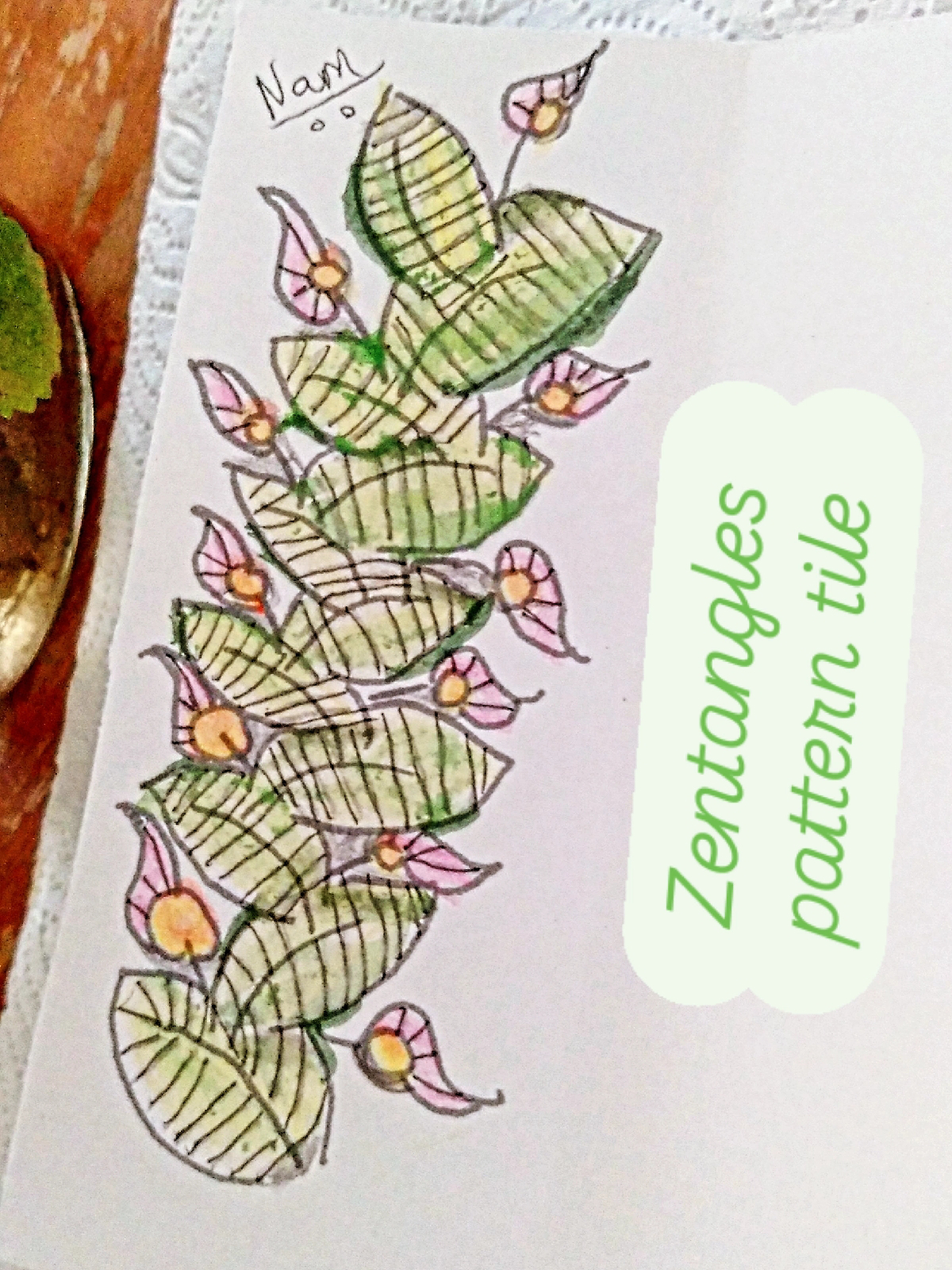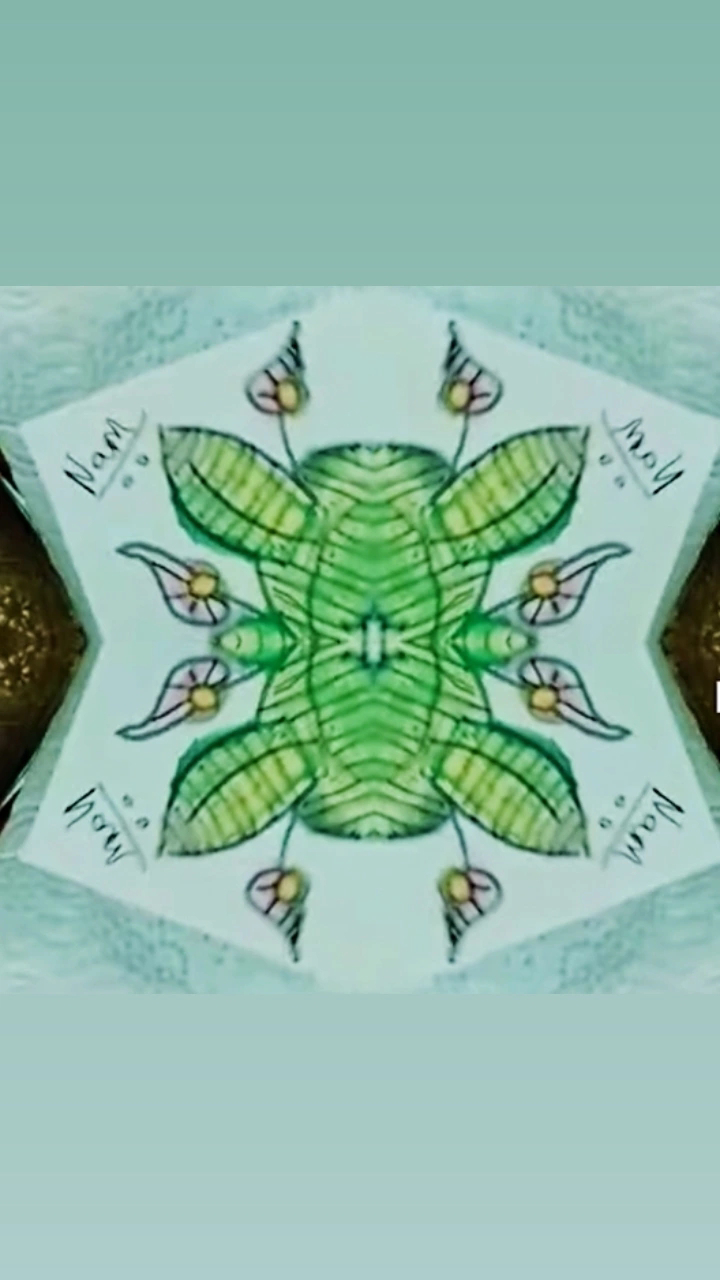First of all the time I had it expanded my project work. So, I have not been able to showcase the black and white print. But, I have displayed the best way a colored image of Zentangles pattern tile.
I liked the image as a whole as the Interwoven leaf and the floral design emerge from the stems which is not seen. It is just mind-blowing.
So, then I thought of transforming this image into awesome patterns.
Next is transfer of the Zentangles image simply by taking a part of the Zentangles image extending the image in an
Drag on the artboard to create a rectangle. Drag until you see a diagonal magenta line to create a perfect square. As you drag, you'll notice an onscreen tooltip next to the pointer that shows the dimensions. You can even look at the picture closely to capture the image.
Zentangles is a meditative drawing style that combines patterns, shapes, and lines to create visually appealing art.
"Climbers Floral" might refer to a specific Zentangle pattern or design that features floral motifs with climbing or intertwining elements.
more information on:
1. Creating your own Zentangle art?
Creating your own Zentangles is a great way to relax and express yourself creatively. Here are some steps to get you started:
*Materials:*
1. Paper (any type will do)
2. Pen or pencil
3. Eraser (optional)
*Basic Steps:*
1. *Start with a shape*: Draw a simple shape, like a circle, square, or triangle.
2. *Add patterns*: Use lines, curves, and shapes to create patterns within the shape.
3. *Repeat and vary*: Repeat patterns, varying them slightly to create interest.
4. *Add shading*: Use hatching, cross-hatching, or stippling to add depth.
*Tips:*
1. *Don't worry about perfection*: Zentangles are meant to be imperfect.
2. *Experiment with patterns*: Try different patterns, like dots, lines, or shapes.
3. *Relax and enjoy*: Focus on the process, not the outcome.
*Inspiration:*
1. Look up Zentangle tutorials online.
2. Explore different patterns and designs.
3. Join a Zentangle community or group.
For more specific guidance or inspiration?
Zentangle "Climbers" it's unique and beautiful in its own way.
Share more about your design?
Let's dive deeper into your Zentangle "Climbers" project.
*Possible exploration areas:*
1. *Pattern development*: How did you come up with the patterns and shapes in your design?
2. *Color usage*: Did you use specific colors or stick to traditional Zentangle black and white?
3. *Inspiration*: What inspired your "Climbers" design?
4. *Meaning*: Does your design hold any personal significance or symbolism?
So, the idea of "Climbers" emerged organically while you were creating the Zentangle pattern. That's the beauty of Zentangles - they can inspire new ideas and creativity!
Did you find that the process of creating the Zentangle helped you relax or focus your mind?
Exploring more Zentangle patterns can be a great way to continue developing your creativity and relaxation skills.
*Some potential ideas to explore:*
1. *Nature-inspired patterns*: Incorporate elements like leaves, flowers, or waves.
2. *Geometric patterns*: Experiment with shapes, like triangles, hexagons, or mandalas.
3. *Abstract patterns*: Create unique, non-representational designs.
Creating Zentangles for personal enjoyment and relaxation is a wonderful way to unwind and express yourself creatively.
*Benefits of Zentangle art:*
1. *Stress relief*: Zentangles can be meditative and calming.
2. *Creative expression*: They allow for personal artistic expression.
3. *Mindfulness*: The repetitive patterns can help focus your mind. There are a relaxing and fun way to create intricate art using repetitive patterns. "Climbers" in this context likely refers to a specific Zentangle pattern or style, potentially inspired by climbing plants or a visual representation of ascending or gaining height. However, "climbers" is not a standard or widely recognized term within the official Zentangle method. Zentangles are known for being easy to learn, with simple elemental strokes like dots, lines, curves, and orbs forming the basis of the patterns.
Here's how to approach creating a Zentangle, including potential interpretations of "climbers":
Basic Zentangle Steps:
Start with Gratitude and Appreciation: Acknowledge the mindful moment and the supplies you'll be using.
Border and String: Create a light pencil border and then a string (a freehand line that divides the space) to give yourself areas to fill.
Elemental Strokes: Use dots, lines, curves, and orbs to create patterns within the sections.
Tangles: Combine these strokes into repetitive patterns, which can be abstract or inspired by natural forms.
Shading: Add shading to enhance the depth and dimension of your design.
Finishing: Sign your work and appreciate the meditative process. Interpreting "Climbers":
- Visual Representation:You could interpret "climbers" as patterns resembling vines, stems, or tendrils that appear to climb or grow upwards.
- Pattern Style: The term might suggest a Zentangle pattern that features vertical or diagonal lines and curves, creating a sense of upward movement.
- Metaphorical Meaning: The idea of "climbing" could also be a metaphor for personal growth, overcoming challenges, or reaching new heights, which can be reflected in the meditative Zentangle process. Tips for Easy Zentangles:
- Start Simple:Focus on basic patterns and gradually incorporate more complex ones as you become comfortable.
- Don't Overthink: Zentangles are about enjoying the process, not creating a perfect piece of art.
- Embrace Imperfection: Zentangles are often asymmetrical and organic, so embrace any variations or mistakes as part of the design.
- Experiment with Tangles: Explore different pattern combinations and find what you enjoy creating.
- Resources:Zentangle.com: The official Zentangle website offers information, classes, and resources.
- YouTube: Search for "Zentangle patterns for beginners" or "easy Zentangle tutorials".
- Pinterest: Explore Zentangle boards for inspiration and ideas.
Zentangle climbers involve creating a series of connected shapes that resemble climbing plants or vines. A simple way to start is by drawing a series of crescent shapes or "C" curves, then adding smaller, curved lines to the base of each to create a layered effect. You can then add more detail with various patterns and shading to give depth and texture.
Here's a step-by-step guide:
1. Start with a base:
Begin by drawing a series of crescent shapes or curved lines. These will form the basic structure of your climber.
2. Add the base:
From the bottom of each crescent, draw a smaller, curved line that connects to the base of the next crescent. This creates a sense of connection and layering.
3. Create the vines:
Connect these crescent shapes with a thin line to make them look like vines.
4. Add details:
You can now add patterns or shading to each section of the climber. Consider using lines, dots, or other simple shapes to create texture. You can also add shading to give the impression of light and shadow.
5. Experiment with variations:
Try different shapes for the base, experiment with different patterns, and explore different shading techniques to create unique and interesting Zentangle climbers.
Tips for Success:
Use light pencil lines: It's easier to correct mistakes with light lines.
Don't be afraid to experiment: Zentangle is all about exploring different patterns and techniques.
Practice makes perfect: Keep practicing and you'll find your own unique Zentangle style.
Zentangle is a relaxing and creative way to express yourself through art. Don't be afraid to try different variations and have fun with it!
Here's a moral story inspired by Zentangles "Climbers":
*The Climber's Journey*
A small, delicate vine began to climb a trellis, twisting and turning around each support. As it grew, it faced obstacles: harsh weather, pests, and uneven support.
But the vine persisted, adapting and adjusting its path. With each step, it grew stronger and more resilient.
*Moral:*
Just like the climber vine, we face challenges in life. But with persistence, adaptability, and determination, we can overcome them and grow stronger.
*Key takeaways:*
1. *Perseverance*: Keep moving forward, even when faced with obstacles.
2. *Adaptability*: Be flexible and adjust to changing circumstances.
3. *Resilience*: Grow stronger through challenges and difficulties.
Another way of inspiring drawing method:
*The Art of Zentangle*
A Zentangle artist began creating a new design, but it didn't turn out as planned. Lines were wobbly, patterns were imperfect, and the overall design seemed messy.
Instead of discarding it, the artist chose to embrace the imperfections. They added more patterns, letting the design evolve organically.
*Moral:*
Embracing imperfections can lead to unexpected beauty and growth. By letting go of perfection, we can discover new possibilities and create something truly unique.
*Key takeaways:*
1. *Embracing imperfections*: Imperfections can be beautiful and unique.
2. *Flexibility*: Adapting to changes can lead to new opportunities.
3. *Creativity*: Letting go of expectations can foster innovation.
Enjoy your Zentangle journey!
Thank you all for visiting my ipage blog and supporting the blog.
Next week we will see some exciting way of capturing Website display.
Cheers,
Gcb studios






Comments
Post a Comment